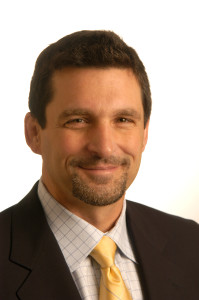By GREGORY WISE
Special Contributor to Silicon Hills News

Scott Harmon, CEO of Noesis Energy
founder and CEO Scott Harmon didn’t set-out to be a serial entrepreneur, but having now started and grown no fewer than four Austin tech companies the title seems to fit.
As part of the leadership team at Tivoli Systems, the poster-child for Austin tech-business success, Harmon helped guide the company to a 1995 IPO and $750 million acquisition by IBM. Not long after, he co-founded Motive, where as president and CEO he led another IPO and grew the company to $100 million in revenue. After leaving Motive, Harmon became CEO of AlterPoint, leading that company to a strategic acquisition.
Today, he seems completely in his element as CEO of venture-backed Noesis Energy, a position he’s held since February 2011. “We’re heavily focused on the opportunity to save $50 million in energy that’s wasted in commercial buildings every year,” Harmon says. “We want to help people reduce that waste.”
Think of Noesis as a match-making service, Harmon says. “We connect building engineers, facility managers, real estate managers, real estate portfolio owners, building owners – anyone who owns a building and pays an energy bill – to energy saving technologies.” Put another way, Harmon jokes, “we’re a dating website for energy efficiency.”
According to Harmon, about a third of Noesis’ customers are public sector institutions, primarily state agencies and municipalities, with the other two-thirds being private-sector. But in both cases the customers’ goal is the same, to reduce spending. Often customers will come to Noesis with a specific energy-saving goal in-place.
“Many businesses will set an annual energy reduction target and it’s usually about five percent,” said Harmon. “Customers look for guidance, counsel and solutions from Noesis. We want to be a trusted partner to the customer. People aren’t confident in sourcing directly from the vendors.
“There are 8,000 companies in the US that sell technology related to energy consumption or efficiency. Talk to their VP’s of Sales and they will commonly say, ‘our technology is too complicated and we’d love a better way to get our technologies into the market.’”
When it comes to acting as a partner, Noesis puts its money where its mouth is. The company makes money as a percentage of customers’ energy savings. The more successful Noesis is at helping a customer reduce energy expenses, the greater the revenue potential.
Executive Q&A with Scott Harmon
Q. What does a “typical” day look like for you?
A. As one of the founders I wanted a scenario where it was possible to work from home. We’d all seen Office Space (Mike Judge’s 1999 workplace satire) enough; we were tired of the cube race. Today I split my time almost evenly between working at the office, from home and on the road. It’s made the lifestyle of this industry better for me; much better than being in an office from 7:00AM to 7:00PM then seeing your family only after that. I embrace a more flexible and connected way of working. I think if you want to kind of keep doing it (working in the start-up/early stage environment) you have to achieve some balance.
Q. What part of your job gives you the most satisfaction?
A. I’m still a technology geek. I graduated from Iowa State, where I went on a wrestling scholarship, earning a Bachelor of Science in Computer Science. I like the building process and interacting with people who build things. The whole process of building has always given me a big charge. I love to build things.
Q. What are the qualities that make someone good at your job?
A. Competitiveness. I’m competitive. I think competition brings out the best in people. It tells you what you’re good at. Tells you what you’re not good at. It’s invigorating.
Q. What the most difficult part of your job?
A. I think for me it’s always wishing you could go bigger and faster. In a perfect world you could have the scale of a larger company with the nimbleness of a start-up.
Q. What experience, or experiences, best prepared you for your job?
A. The way I grew-up in Iowa. I grew-up 50 miles from the Field of Dreams cornfield. It was a very rural, very-Midwestern upbringing. That, wrestling, and majoring in Computer Sciences all prepared me.
Q. Why do you choose to live and work in Central Texas, as opposed to other tech-centric parts of the country?
A. It has the best blend of the various lifestyles. You’ve got the tech community, it’s affordable, and it’s a good place to raise a family. Honestly, I don’t think there’s even a close second. If you want to do the “All-Tech” thing, go to Silicon Valley, but you’ll be back.
Q. Outside of your current position, what’s your dream job and why?
A. It would be another start-up.
Q. What’s the best advice you’ve ever gotten?
A. Always know what can kill your business versus what can only hurt you. As a CEO I feel a really strong sense of personal responsibility and care for the people who work for me. It’s really heavy, in a good way, it’s a big motivation.
Q. Who is your role model?
A. Bob Metcalfe. He is about great technology first. Bob is a great example.
Q. What’s the first electronic gadget you remember owning?
A. A cell phone. The cell phone collapsed distances more than anything that came before it.
Q. What’s the one piece of technology you couldn’t live without?
A. My laptop. It’s still the most productive thing I have. The laptop crushes the tablet, iPhone, any other piece of media I have. It’s far and away my favorite.
Q. What do you think is the most important technology in-use today?
A. Search is the most important; it’s how anybody can know anything. That’s huge. The personal cost of search approaches zero, yet you can know anything. You can know the biology of your cancer if you’re a cancer patient, for example.
Q. What do you think is the most underrated technology in use today?
A. Meters, all types of meters. Meters are going everywhere. Google Traffic has individuals metering the distance they’ve traveled in a certain amount of time, establishing traffic patterns. Energy meters are measuring energy at points in time. The interval for energy metering used to be a month. A Meter Reader would come around and read total consumption and peak consumption. Now energy is read every five minutes. This is the flip side of analytics.
And I think peer-to-peer connectivity is underrated; we’re just beginning to see the power of crowds. Noesis is a strong peer-to-peer example. People in the Noesis community advise each other on energy efficiency. I was just reading about peer-to-peer funding. A cool company called LendingClub that allows people to lend to other people. There’s Airbnb and others. The power of people to deal directly with each other. That scale, that enormity, is pretty fascinating.
Q. What do you think is the most overrated technology in use today?
A. The concept of the Smart Home is the most overrated. There’s no such thing as a Smart Home! And do you really want webcams throughout your house? That’s horrifying on so many different levels!

Gregory Wise, vice president with Weber Shandwick
Gregory Wise is an Austin-based marketing and communications professional with the PR firm Weber Shandwick. He can be reached at Gregory Wise
Editor’s Note: Gregory Wise will write the Innovator’s Insights column for Silicon Hills News on accomplished technology experts in Austin. To be considered for the column, please contact him at
Gregory Wise.
![]() This week, Silicon Hills News launched its first Kickstarter crowdfunding campaign to create a slick print magazine to be released at South by Southwest Interactive.
This week, Silicon Hills News launched its first Kickstarter crowdfunding campaign to create a slick print magazine to be released at South by Southwest Interactive.